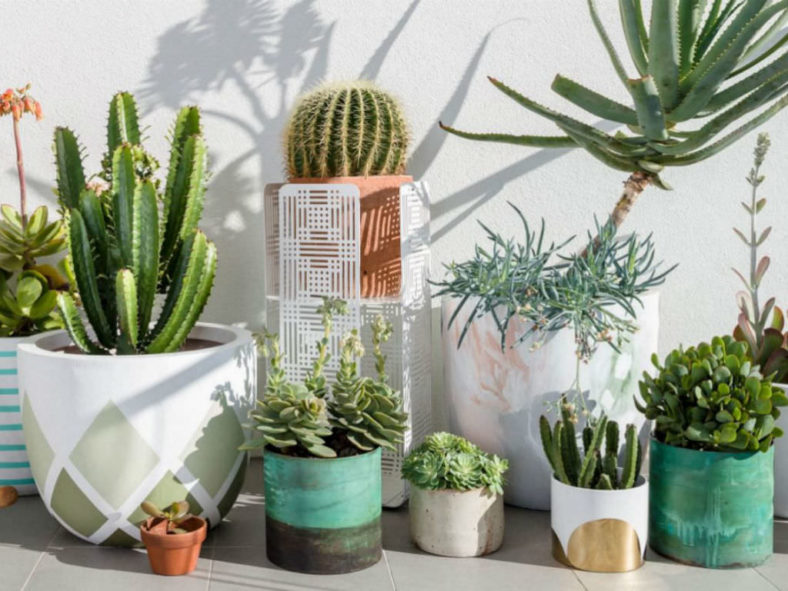1. Overwatering
Overwatering is one of the most common problems when growing cacti and succulents. Generally, plants should be watered in the summer at 7- to 10-day intervals if grown in well-draining soil, more often if sandy, and less frequently if the soil is heavier. The irrigation should be reduced in the winter because most succulents go dormant.
Tip for the summer: Learn about your plant water needs by checking the root zone 2 to 3 inches (5 to 7.5 cm) below the surface before watering. It should be dry. If in doubt, do not water.
2. Underwatering
"Cacti do not need water" is a myth. They need water to live, just like any other plant. The temperature affects the rate of desiccation. Many cacti and succulents do not need to be watered over the winter, but giving them a little water is best to prevent the loss of roots. If the roots have dried up, water the plant very lightly until the roots take hold.

3. Not Providing the Proper Amount of Sunlight
Just because cacti and succulents are often found in arid habitats does not mean they can be placed or planted in full sun. Many species grow where they get a degree of shelter from rocks, larger plants, and the environment. Growers should be cautious as they place their plants from a sheltered position into a more light-filled area. Young barrel cacti, columnar cacti, and some Yuccas can be sunburned with permanent scars.
Tip: Use a shade cloth (30%) to protect plants from the fierce summer sun. On the other hand, not exposing the plants to enough sunlight creates pale, sickly, or abnormally-looking plants. Rotate plants often to ensure they receive the same amount of light.
4. Failure to Use the Proper Soil Mix
Many beautiful and inexpensive plants from local nurseries are planted in a peat-based medium. This medium is difficult to water correctly, and it inevitably becomes too wet or too dry. We recommend using a commercial potting soil mix for succulents mixed with perlite, sand, or small gravel. Good soil mixes for Lithops include 10 to 20% potting soil and 80 to 90% gravel. For most cacti and succulents, a recommended mix is 30% to 40% potting soil and 60% to 70% gravel. A 50% potting soil with 50% perlite is a good mix for succulents like Sanseverias, small Agaves, and Yuccas. A 50% to 60% potting soil and 40% to 50% gravel mix is recommended for leafy succulents, such as Adeniums.
5. Fertilizing Improperly
A common cactus and succulent faux-pas is the idea that they do not need fertilizer! Like any other plant, they need a variety of macro and micronutrients to survive. While they get along just fine without it, sometimes some fertilizer can be the key to having lush and green plants.
6. Ignoring the Plant's Requirements for Growth
It is essential to know the growth habits of your plants. For example, most cacti and succulents should be grown at temperatures between 75ºF and 90ºF (24ºC and 32ºC), and some may require trace minerals in the soil. These can be provided by fertilizing, but the common fertilizers must be used appropriately, usually at 0.25 strength, or a slow-release product should be used.
Tip: A fertilizer for tropical plants is perfect. Use a fertilizer with lower nitrogen content if your plant is variegated (light or pale green, tinging towards white or silver).
7. Leaving Plants Root-bound for Too Long
The roots must have enough room to grow and thrive. The roots of plants that have grown in a pot for a long time fill the entire pot in a tight mass, creating desiccation problems because water may have difficulty penetrating the mass. The roots also cease to acquire nutrients, and the plant could perish.
Tip: Repot when roots begin to show through the drainage hole.
8. Poor Planning When Landscaping
Landscaping with cacti and succulents is becoming increasingly popular, but poor planning can lead to disaster. Some key elements for success include building a raised bed by mounding the soil or constructing a large in-ground planter. This is similar to a raised vegetable planter. The bed should be 8 to 12 inches (20 to 30 cm) above the surrounding area. A raised bed promotes drainage, which is crucial for success with various cacti and succulents. The soil mix must be fast-draining but not too lean. A combination of expanded shale or pea gravel with sharp sand and compost is a good general-purpose blend. Test your blend. Water should not stand on the surface for more than a few seconds before entering the soil. If possible, plant early in the spring, and be prepared to shelter plants under netting until they are well-established.
Tip: Choosing the right landscape plants is best done with advice from those who have succeeded.
9. Planting Incompatible Plants in a Dish Garden
For a dish garden, use succulents with similar growing conditions. Use plants that require watering at the same time, such as ball-shaped cacti like Echinocactus, taller-growing cacti like Echinocereus, or succulents with elongated or thick fleshy leaves. Use plants with the same growing seasons, such as Haworthias and Aeonium for wintertime or Crassula with Sempervivum or Echeveria.
10. Burning Plants Due to Phototoxicity
Cacti and succulents do not get infested by insects (such as scale) as often as other plants. However, they are susceptible, and on occasion, we must treat them with insecticides when manual removal of bugs is not enough. Plants treated with chemicals must be protected from the sun. Otherwise, they will get burned easily, especially with products that contain oils.
Tip: Isolate plants with scale or other insects, and protect them from the sun.
Source: hcsstex.org
Links
- Succupedia: Browse succulents by Scientific Name, Common Name, Genus, Family, USDA Hardiness Zone, Origin, or cacti by Genus